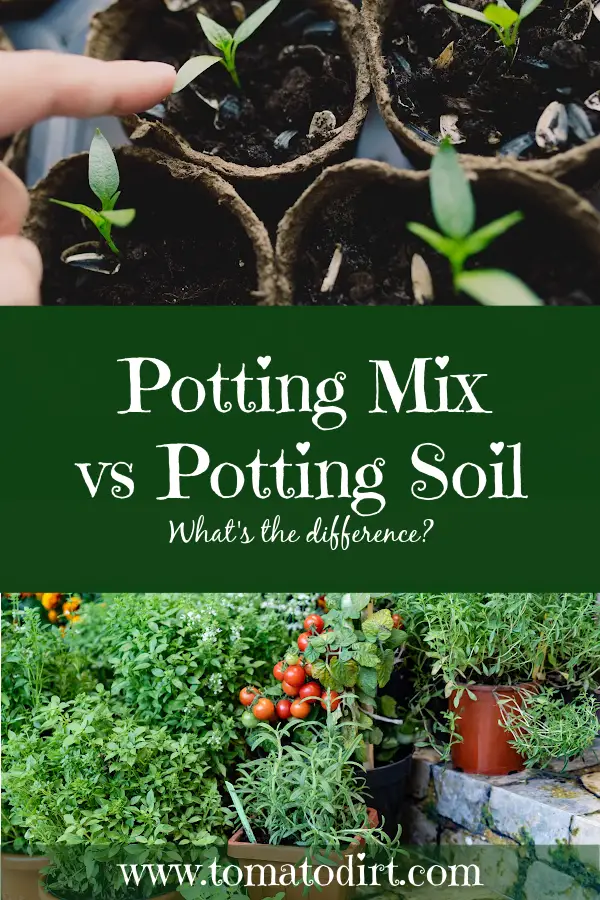FREE: 10 Must-Know Tomato Growing Tips Get The Guide
Read our affiliate disclosure here.
Potting Mix vs Potting Soil: Which Should You Use?
Since 2010, Tomato Dirt has garnered 4.8+ million views, making it the web’s leading online source for growing tomatoes in the home garden. Award-winning writer and Tomato Dirt owner Kathy Widenhouse has helped thousands of home gardeners grow healthier tomatoes. Be one of them when you get Tomato Dirt’s Growing Guide here.
Updated 3.20.25
Potting mix vs potting soil: gardeners use the words interchangeably. So it’s natural to think that they are one and the same.
They’re not. Each one has a different role in growing tomatoes and other crops. And each has different ingredients, too.
Potting mix vs potting soil: the main differences
What’s potting mix?
A potting mix is used to start seedlings. It contains exclusively soilless and sterile ingredients. Those can include perlite (volcanic glass), peat moss (plant fiber), and vermiculite (minerals). An absence of soil means an absence of pathogens and fungi. A soilless medium gives new seedlings the chance for a disease-free start in life. If you want to grow your own tomato seedlings, start with a potting mix. Then you’ll move on to …
What’s potting soil?
Potting soil is used to transplant seedlings or to fill containers that will become a seedling’s new home. What sets it apart from potting mix is that it contains fertilizer to help the new plant have the nutrition it needs grow strong. Potting soil provides both a good home plus food.
And here’s a surprise: potting soil may or may not contain soil! Every potting soil has a unique recipe and proprietary ratios. Because of that, you’ll shop for a commercial potting soil the same way you shop for groceries: read the labels. Choose a potting soil that’s designated for your specific crop. Most potting soils contain these four big-picture ingredients.
- Organic materials: peat moss, compost, bark, topsoil, coconut coir, guano, worm castings
- Inorganic materials: perlite, vermiculite, sand, cinder, rock dust, charcoal
- Fertilizer: organic or synthetic; quick-acting or time-release
- Additives: wetting agents, lime, microbes
Potting soil vs garden soil
Speaking of labels, read them carefully. Does the package say “potting soil” or “garden soil”? Yep, there’s a difference. In the potting mix vs potting soil debate, other products like these rise to the surface.
Garden soil may be less expensive than other products, but it’s not a healthy option for growing seedlings or even in containers. It’s too heavy.
Garden soil is potting soil that’s been “watered down,” so to speak. It’s got added clay, sand, compost, or other inexpensive ingredients designed to extend it. If you mistakenly purchased garden soil rather than potting mix or potting soil, work it into your garden plot.
Potting soil vs compost
Compost is organic matter (grass clippings, leaves, plant refuse from the kitchen) that breaks down over time. It’s used to amend garden soil. Meaning if you have clay-dominated soil, compost improves drainage. If your soil is sandy, compost helps retain water. And in all cases, compost pumps nutrients and minerals into your soil.
Yet as organic matter, it’s markedly different from potting soil – which contains both organic and inorganic ingredients. In fact, screened compost is often a component in potting soil. If you start or grow tomato seedlings exclusively in compost, you’ll overwhelm them. Instead, work compost into your containers or garden plot to make them a rich, healthy home for plants.
Potting mix vs potting soil for tomatoes
Should you use potting mix or potting soil for starting tomato seeds? The answer is yes – both.
When you start tomato seeds, use a potting mix. The reason is simple. You want to give emerging seedlings the best chance for survival. That means eliminating any chance of disease. A soilless medium, such as a potting mix, increases your odds for germinating healthy tomato seedlings. Plus, the seed itself provides nutrients to nourish the tomato plant’s first sets of leaves.
But once it’s time to transplant seedlings to bigger pots, then use potting soil for your tomatoes’ new home. Reason? Your tomatoes need more nutrition. They’ve used up all the food in the seed itself. Now, they need lots of energy to put out new shoots and leaves.
The best potting mix for tomatoes may or may not be sterile, yet it must contain nutrients to grow healthy plants. Additional nutrients will allow them to grow stronger stems, leaves, and blossoms to withstand hardening off so they’re ready for the shock of the garden. Your job as gardener is to manage that transition so it’s smooth as possible for your tomato plants. Do what you can to help them.
Because in just a few short weeks, they will reward you with luscious fruit.
More tips on potting mix
What potting mix to use when starting tomatoes from seeds ...
What potting mix should you use for growing tomatoes in pots?
How to Make Your Own Potting Mix for Growing Tomatoes ...
Sterile potting mixes: do you need them for growing tomatoes?
Review: Pro-Mix Seed Starting Formula for growing tomato seeds ...
Review: Coco Coir as a Potting Medium for Tomatoes ...
Seed starting mix for tomatoes: what ingredients are important ...
More Tomato Seedling tips on our Pinterest board ...
Return from Potting Mix vs Potting Soil to Tomato Dirt home
As an Amazon Associate and Rakuten Advertising affiliate I earn from qualifying purchases.
SHARE THIS PAGE:
FREE! 10 Must-Know Tomato Growing Tips: 20-page guide
Get yours here:




